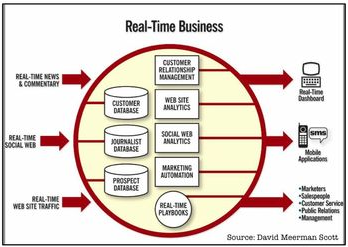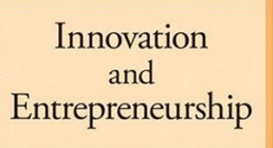
The pace at which business is moving is now; really, you’re already behind. In the brief second it took you to read that very statement, I’ve cost you (an opportunity cost granted) the time to focus on something else, relevant to your business, happening, right now. We’ve always been pretty capable of dealing with those opportunities coming from within the business; after all, as an executive, manager, founder, or CEO, it’s your job to know what’s going on within the company and react to those things as they happen. But one only need to look at our history with marketing plans, product roadmaps, and long term goals to affirm that we’ve never excelled at dealing with external forces in the now.
As Marketers, it generally falls to us first to know and react to those external forces. Sure, of course, so too does Sales, Customer Support, and PR, but the very purpose of Marketing is keep tabs on your customers and increase the value delivered to them through your communication, products, and services (trust me, I looked it up). Every marketer is skilled at doing this through the particular channel in which they tend to work (email, TV, search, print) but how might we even conceive of doing it as on-demand as we do internally – knowing exactly what our customers think now, and reacting to that? To start at the beginning, I shared with Dachis Group the very definition of what you’d call Real-Time Marketing.
“Real-time marketing is “on-the-fly” participation by brands in the events, topics, and ideas trending at that very moment among target audiences online,” said Paul O’Brien (it’s really weird quoting yourself)
With the proliferation of social media, customer feedback, news, and stories about your industry and business occur in real-time, at a pace with which you can’t possibly keep up without some tools and resources at your disposal. That initial set of thoughts on the definition of real-time marketing prompted a host of questions to which Dachis Group responded, in nearly real-time:
How do you Actually Accomplish Marketing in Real-time?
“The trend is most famously exemplified by successful marketing tactics like Oreo’s tweet from the SuperBowl blackout,” noted Brian Kotlyar, Director of Marketing for Dachis Group, in their follow up Making Real-Time Marketing a Reality, “and disastrous ones like Kenneth Cole’s tweet about protests in Egypt or Epicurious’ tweets following the Boston marathon bombing.”
Kotlyar points out that there are three key components to effective real-time marketing:
- Brand Trend Identification – Automatically and immediately surfacing topics and news that matter most to a brand’s specific audience
- Virtual Marketing Workflow – A collaborative workflow tool that highlights trends and routes them across your organization (or agency) for review, product, approval, and syndication
- Comprehensive Social Analytics – Unified social analytics across campaigns and day-to-day content enabling the organization to evaluate and optimize that engagement
Social Analytics, of course, are not unlike a technique I explored here years ago: using search and user behavior therein to measure ad campaign performance. It’s the promise of Social Analytics, fulfilled by something like Dachis Group’s platform, that make real-time marketing possible.

David Meerman Scott, author of Real-Time Marketing and PR, has lead us down this path with some thought leadership such as that which you see here. News, social data, and website monitoring, funneled into unified databases, your CRM, analytics tools, and even marketing automation, to provide dashboards, mobile tools, and actionable intelligence for your entire organization.
When you consider the implications of all of that technology on the job of a marketer, it’s no surprise that many forecasts confirm that CMOs are on track to overtake CTO/CIO budgets with regard to dollars spent on tech. Visualize that even further throughout your organization and you might appreciate why Scott Brinker, CIO of Ion Interactive, is pointing out that the CMO of today is tomorrow’s CEO.
Is Real-Time Marketing Really That Far Reaching?
Consider this simply a thought exercise. Real-time marketing is a reality; as you explore the concept and it’s potential though, it’s hard not to consider the reality of the future – that the executive capable of reacting to the market on the fly leads the company with the most significant competitive advantage. Imagine, for example, how Microsoft could have fared very differently during E3 and their announcement of the Xbox One had they leveraged real-time marketing, not just to monitor, but to react to the significant backlash to their intention to use an incredibly archaic DRM. Rather than letting the public outcry spin out through memes, viral videos, and complains that practically destroyed the Xbox market share, they could have immediately reacted and softened or altered course.
For every worse case scenario validating the potential of real-time marketing, we can easily explore those that are doing amazing work with the concept. National Instruments, a exceptional company known by most for being a company that know one knows what they do, has developed a history of success and constant growth, by being at the forefront of what you might simply call real-time technology. With a graphic based testing framework (think of the old GUI term we used to describe Windows years ago), National Instruments is making it easy for technology companies to test and react in real-time. Their work is enabling industries such as energy to developing solar arrays that perform far more efficiently than anything else on the market because they react to the weather in real time.
Business happens at the pace of now and evident to me is not a question of whether or not that statement is true or even how you create a real-time organization. Rather, how we shift our culture to recognize that real-time marketing holds the promise to change everything about how we live, work, and learn. Just imagine… how cool would politics be in the United States if the next Presidential election was exposed, validated, and delivered in real-time, and we had the opportunity to engage candidates just as quickly.


